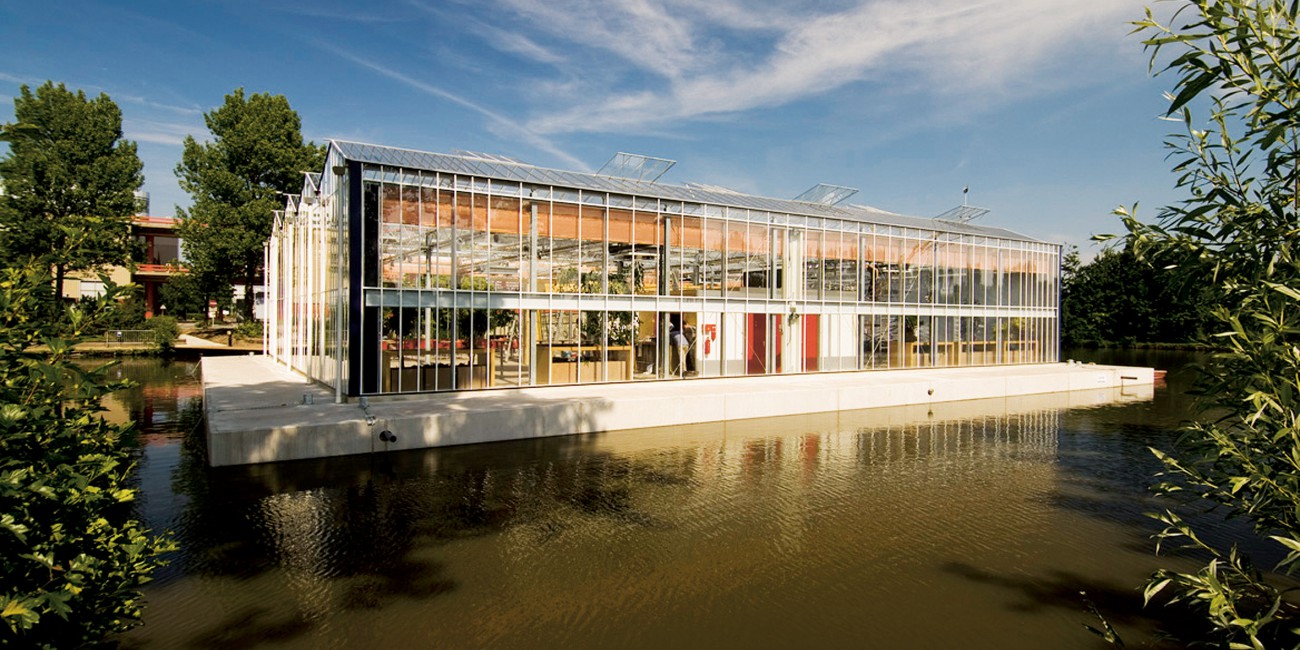Definition
The basic characteristic of floating buildings is that they are not supported by a firm foundation, but float on water. Traditional foundations are therefore not required. The position of a floating building is permanently fixed in a horizontal direction, while it can flexibly follow vertical variations in water level. The base of a floating home consists of a floating mechanism that secures the building’s buoyancy. The bottom level of the entire construction should be at least 1 meter from the water bottom in order to maintain favourable water quality conditions. It is essential that a floating building never touches firm ground, because the construction is not designed for such conditions. The floating mechanism that is positioned at the basis of the floating structure can consist of high-density expanded poly-styrene or a hollow, concrete structure. Hollow space can be used for storage of light goods. Floating homes can have terraces that can be regarded as a small-scale version of traditional gardens. Infrastructure connections to floating buildings should be designed so at to be able flexibly cope with expected water level variations (SlideShare, Floating technology, accessed on Sept. 2016).Co-benefits and impacts
Floating buildings have environmental benefits such as unsusceptibility to changes in sea level, and minimisation of disturbance to the ecology of the harbour or seabed. They can be built off-site and then towed into location, minimising disturbance to the build site. If the building is decommissioned, it can be relocated elsewhere (Wikipedia, Floating building, accessed on Sept. 2016).Definition (GR)
Το βασικό χαρακτηριστικό των πλωτών κτιριακών εγκαταστάσεων είναι ότι δεν υποστηρίζονται από σταθερά θεμέλια αλλά επιπλέουν στο νερό. Συνεπώς δεν απαιτούνται τα παραδοσιακά θεμέλια. Η θέση του πλωτού κτιρίου στερεώνεται μόνιμα σε οριζόντια κατεύθυνση, ενώ μπορεί να ακολουθεί ευέλικτα τις κάθετες διακυμάνσεις της στάθμης του νερού. Η βάση μιας πλωτής κατοικίας αποτελείται από έναν πλωτό μηχανισμό, ο οποίος εξασφαλίζει την άνωση του κτιρίου. Το κατώτατο επίπεδο όλης της κατασκευής θα πρέπει να είναι σε απόσταση τουλάχιστον 1 μέτρου από τον πυθμένα της υδάτινης μάζας για τη διατήρηση ευνοϊκών συνθηκών ποιότητας του νερού. Είναι σημαντικό ένα πλωτό κτίριο να μην αγγίζει το σταθερό έδαφος, επειδή η κατασκευή δεν έχει σχεδιαστεί για αυτές τις συνθήκες. Ο πλωτός μηχανισμός που τοποθετείται στη βάση της πλωτής δομής μπορεί να αποτελείται από ένα υψηλής πυκνότητας διογκωμένο πολυ-στυρένιο (φελιζόλ) ή μία κούφια δομή σκυροδέματος. Ο κενός χώρος μπορεί να χρησιμοποιηθεί για την αποθήκευση ελαφρών πραγμάτων. Οι πλωτές κατοικίες είναι δυνατόν να έχουν επίπεδες στέγες (ταράτσες), οι οποίες μπορεί να θεωρηθούν ως μικρής κλίμακας παραδοσιακοί κήποι. Οι συνδέσεις της υποδομής των πλωτών κτιρίων θα πρέπει να σχεδιάζονται έτσι ώστε να μπορούν να αντιμετωπίσουν με ευελιξία τις αναμενόμενες διακυμάνσεις της στάθμης του νερού (SlideShare, Floating technology, accessed on Sept. 2016).Co-benefits and impacts (GR)
Τα πλωτά κτίρια έχουν περιβαλλοντικά οφέλη, όπως ανθεκτικότητα στις μεταβολές της στάθμης της θάλασσας και ελαχιστοποίηση της οικολογικής διατάραξης του λιμένα ή του θαλάσσιου βυθού. Μπορεί να κατασκευάζονται εκτός του χώρου εγκατάστασης και στη συνέχεια να ρυμουλκούνται στη θέση τους, ελαχιστοποιώντας τη διατάραξη στο χώρο εγκατάστασης. Σε περίπτωση παροπλισμού του κτιρίου, μπορεί να μετακινηθεί σε άλλη θέση (Wikipedia, Floating building, accessed on Sept. 2016).Flood management measure
The parent measure, in terms of this measure being a subcategory of the parent one
Last modified: March 4, 2020, 8:13 a.m.


 Ελληνικά
Ελληνικά

